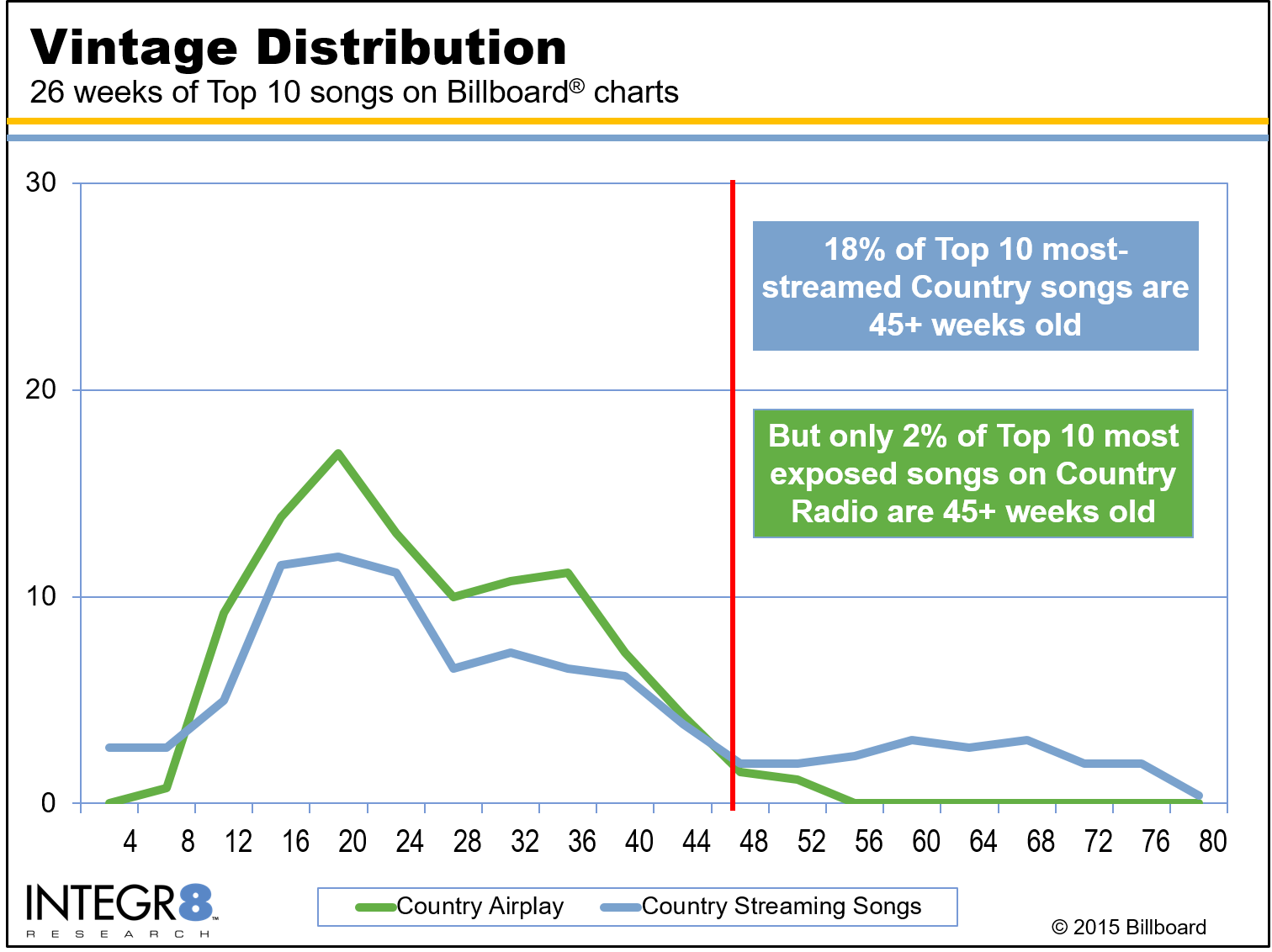This is the second in a three part series examining the differences between Country and CHR.
In our last post, we examined Country listeners’ streaming habits to show how new Country hits take longer to grow, peak and decline than CHR’s big hits typically do. What happens after a big hit’s initial run as a Current and it becomes a Recurrent? Listeners’ streaming behavior reveals another key difference between Country and CHR:
Country listeners have an appetite for recurrents that CHR listeners don’t.
For the first 44 weeks of a song’s life, the vintage of the new music listeners hear on the radio closely mirrors what they play for themselves on streaming services. However, there is a select batch of Country super hits that remain Top 10 in streaming far longer than they remain currents on Country radio. Eighteen percent (18%) of the Top 10 songs on the Country streaming chart are 45 weeks old or older. In comparison, a scant 5% of the Top 10 most streamed CHR songs are 45+ weeks old.
The songs that remained among the Top 10 most streamed Country songs include huge hits such as Luke Bryan’s “Play It Again” (still Top 10 in streaming at 64 weeks), “This Is How We Roll” from Florida Georgia Line (stayed Top 10 until it was 74 weeks old), and Brantley Gilbert’s “Bottoms Up” (still among the Top 10 most streamed country songs at 83 weeks).
While 18% of the Country songs listeners stream most are 45+ weeks old, a scant 2% of the Top 10 songs in Country radio airplay are 45+ weeks old. That’s because radio has almost always moved songs that are over 44 weeks old to recurrent categories or has stopped playing them entirely.
Figure 1: The songs listeners hear on Country Radio closely match the vintage of the songs they play on streaming services for songs less than 45 weeks old.
Are radio programmers making a mistake?
No—and here’s why: Integr8 New Music Research confirms that, “Play It Again,” “This Is How We Roll” and “Bottoms Up” all remained listener favorites for as long as they remained big in streaming. “Bottoms Up”, for example, was still #1 in popularity at 77 weeks. However, new music research also captures the additional dimension of how many listeners are getting tired of hearing each song—and all three of these songs were among the top five songs listeners were sick of hearing.
While Country has lower burn scores than CHR (often, the most-burned Country songs in our Integr8 New Music Research are only half as burned as our CHR clients’ most burned songs) this combination of strong appeal and high burn indicates that listeners still love these smash hits, but they don’t want to hear them as often as they did when they were current hits.
In other words, these songs are power recurrents.
So why should radio play these super hits less frequently if they’re still among the Top 10 most streamed Country songs?
- Haters don’t hurt streaming, but they can hurt radio: For Spotify, it doesn’t matter how many people are tired of song, or even how many people hate a song: How often people who love it play it is the only thing that matters. For radio, playing a song some listeners hate, or a song they simply don’t want to hear as often as they used to, can cause them to tune out your station.
- Listeners want their Country station to keep them up to date with the latest Country hits. In perceptual research, Country listeners are consistently clear that they want their favorite Country station to keep them up to date with the latest hits. Even if listeners crank up the volume when that year-and-half old song they love comes on, your reputation for playing the latest Country hits can head south if listeners are always hearing last year’s songs when they tune in. In other words, playing listeners tried and true favorites as if they were still currents might not hurt you today, but it could make your station seem stale tomorrow.
Bottom line: Songs that listeners still love after 45 weeks should be in your power recurrents.
Our next post will showcase the difference in how Country and CHR listeners emotionally connect with their favorite music, and how understand this difference will help you make better new music decisions.



